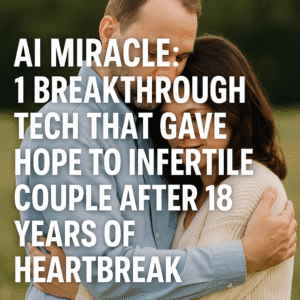AI Miracle: 1 Breakthrough Tech That Gave Hope to Infertile Couple After 18 Years of Heartbreak
After 18 heartbreaking years of failed IVF attempts, a couple achieved pregnancy thanks to an AI breakthrough targeting severe male infertility. Diagnosed with azoospermia—where sperm are virtually undetectable—traditional methods couldn’t find the husband’s hidden sperm. Columbia University’s STAR (Sperm Tracking and Recovery) system changed this: using high-speed imaging and AI trained on millions of sperm samples, it identified elusive sperm missed by human embryologists.
Fertility expert Dr. Anjali Malpani emphasizes this technology “multiplies human effort,” acting as a powerful tool to augment—not replace—embryologists’ skills. Costing under $3,000, STAR offers a non-invasive, accessible solution for cases once deemed hopeless. This represents a critical shift: AI is now tackling specific, profound challenges in fertility treatment, turning enduring hope into tangible life-changing outcomes. The story underscores technology’s role as a partner in deeply human journeys of resilience.

AI Miracle: 1 Breakthrough Tech That Gave Hope to Infertile Couple After 18 Years of Heartbreak
The dream of parenthood can feel like an impossible horizon after 18 years of heartbreak, countless IVF cycles, and the crushing diagnosis of male infertility so severe that even finding a single sperm seemed futile. For one couple, that horizon finally shifted, not just through medical persistence, but with the quiet intervention of an unexpected ally: artificial intelligence.
Their story pivots on a condition called azoospermia – a diagnosis meaning no sperm are detectable in the ejaculate, even after meticulous laboratory processing. Traditional methods, relying on the skilled eyes of embryologists examining centrifuged samples under high-powered microscopes, had repeatedly drawn a blank. The husband’s sperm weren’t absent; they were effectively invisible, hidden in minuscule numbers among other cells.
Enter the STAR System: Developed at Columbia University Fertility Center, this AI-powered tool (Sperm Tracking and Recovery) represents a paradigm shift. Here’s how it transforms the search:
- High-Speed, Hyper-Detailed Scanning: A semen sample is placed on a specialized chip. A high-speed camera connected to a microscope feeds millions of images (over 8 million in under an hour) to the AI.
- Trained Precision: The AI has been trained on vast datasets to recognize the distinct visual signatures of viable sperm cells – shapes, structures, and movements – with superhuman consistency.
- Pinpointing the Invisible: It scans the entire sample rapidly and relentlessly, identifying sperm that human eyes, no matter how experienced, could easily miss due to fatigue, sample complexity, or sheer scarcity.
- Guided Recovery: Once identified, the system helps embryologists precisely locate and recover these precious, previously undetectable sperm cells.
“This is technology multiplying human effort,” explains Dr. Anjali Malpani, a renowned IVF specialist. “Embryologists do incredible work, but AI acts as a powerful augmentation of their vision and stamina. It allows them to find sperm they might not have seen otherwise, particularly in these extremely challenging cases.”
Why is this a breakthrough beyond just “finding sperm”?
- Hope for Severe Male Infertility: It offers a concrete solution for men with non-obstructive azoospermia (where sperm production is severely low), previously often deemed untreatable with their own sperm.
- Non-Invasive & Cost-Effective: Unlike surgical sperm extraction techniques (like TESE or micro-TESE) used for obstructive azoospermia (where sperm are produced but blocked), STAR works with the ejaculated sample. At under $3,000, it’s significantly less expensive than surgical options.
- Reducing Human Limitations: It mitigates the impact of human fatigue and the overwhelming task of searching vast sample areas for vanishingly rare sperm.
AI: Partner, Not Replacement
Dr. Malpani and other experts are quick to emphasize a crucial point highlighted in the original report: AI is an assistant, not a replacement. “Each IVF case has unique complexities demanding the experience and judgment of a trained embryologist,” she notes. Grading embryos, making nuanced decisions about fertilization and transfer protocols – these remain deeply human skills honed by years of experience. AI excels at specific, pattern-recognition tasks like sperm identification, freeing embryologists to focus on higher-level clinical decisions.
The Human Impact
For the couple who endured 18 years of disappointment, the STAR system wasn’t just a technological novelty; it was the key that unlocked a door they thought was permanently sealed. It located the hidden sperm, allowing for fertilization via ICSI (Intracytoplasmic Sperm Injection) and a successful embryo transfer. Their journey underscores a profound shift: AI is moving from abstract concept to tangible partner in deeply human stories of resilience and hope.
The Future Fertility Landscape
The success of tools like STAR signals a new frontier in reproductive medicine. It demonstrates AI’s potential to tackle specific, critical bottlenecks in infertility treatment – particularly those involving extreme scarcity or detection challenges. While it won’t solve all infertility issues, it offers a powerful, targeted solution where traditional methods fall short. As these technologies evolve and integrate responsibly under expert guidance, they hold the promise of rewriting endings for more couples whose dreams of parenthood have long seemed out of reach. It’s a testament to how technology, thoughtfully applied, can illuminate the once invisible and turn enduring hope into tangible joy.
You must be logged in to post a comment.